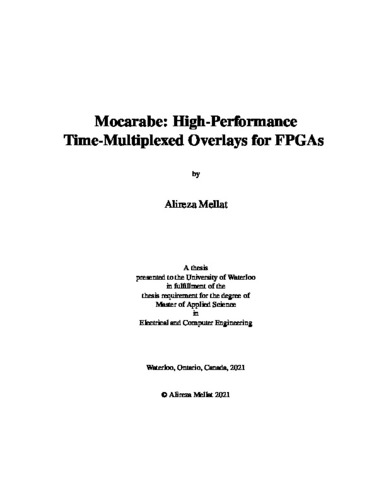| dc.contributor.author | Mellat, Alireza | |
| dc.date.accessioned | 2022-01-27 18:13:07 (GMT) | |
| dc.date.available | 2022-01-27 18:13:07 (GMT) | |
| dc.date.issued | 2022-01-27 | |
| dc.date.submitted | 2022-01-24 | |
| dc.identifier.uri | http://hdl.handle.net/10012/17993 | |
| dc.description.abstract | Coarse-grained reconfigurable array (CGRA) overlays can improve dataflow kernel throughput by an order of magnitude over Vivado HLS on Xilinx Alveo U280. This is possible with a combination of carefully floorplanned high-frequency (645 - 768 MHz Torus, 788 - 856 MHz Mesh, 583 - 746 MHz BFT) design and a scalable, communication-aware compiler. Our CGRA architecture supports configurable Processing Element (PE) functionality supported by a configurable number of communication channels to match application demands. Compared to recent FPGA overlays like 4×4 ADRES and HyCUBE implementations in CGRA-ME, our design operates at a faster clock frequency by up to 3.4×, while scaling to an orders-of-magnitude larger array size of 19×69 on Xilinx Alveo U280.
We propose a novel topology agnostic ILP placer that formulates the CGRA placement problem into an ILP problem. Our ILP placer optimizes placement regardless of topology and even for non-linear objective functions by using pre-computed placement costs as inputs to the ILP problem formulation. Using the ILP placer reduces placement quadratic wirelength up to 37% compared to the commonly used simulated annealing approach but increases runtime from less than a minute to hours.
Our communication-aware compiler targets HLS objectives such as initiation interval (II) and minimizes communication cost using an integer linear programming (ILP) formulation. Unlike SDC schedulers in FPGA HLS tools, we treat data movement as a first-class citizen by encoding the space and time resources of the communication network in the ILP formulation. Given the same constraints on operational resources as Vivado HLS, we can retain our target II and achieve up to 9.2× higher frequency. We compare Torus and Mesh topologies, and show Mesh has less latency per area compared to Torus for the same benchmarks. | en |
| dc.language.iso | en | en |
| dc.publisher | University of Waterloo | en |
| dc.subject | CGRA | en |
| dc.subject | FPGA | en |
| dc.subject | Compiler | en |
| dc.subject | RTL | en |
| dc.subject | Overlay | en |
| dc.title | Mocarabe: High-Performance Time-Multiplexed Overlays for FPGAs | en |
| dc.type | Master Thesis | en |
| dc.pending | false | |
| uws-etd.degree.department | Electrical and Computer Engineering | en |
| uws-etd.degree.discipline | Electrical and Computer Engineering | en |
| uws-etd.degree.grantor | University of Waterloo | en |
| uws-etd.degree | Master of Applied Science | en |
| uws-etd.embargo.terms | 0 | en |
| uws.contributor.advisor | Kapre, Nachiket | |
| uws.contributor.affiliation1 | Faculty of Engineering | en |
| uws.published.city | Waterloo | en |
| uws.published.country | Canada | en |
| uws.published.province | Ontario | en |
| uws.typeOfResource | Text | en |
| uws.peerReviewStatus | Unreviewed | en |
| uws.scholarLevel | Graduate | en |

